Imagine this: you go to your garden, expecting to be greeted by your gorgeous plants. Instead of seeing luscious and happy plants, however, you instead see most of your plants wilting in the heat of the sun! Don’t be embarrassed if you have found yourself in this exact situation; it happens to most gardeners, from beginners to professionals.
While there are many reasons why your plants may be dying, one of the most common is that you are growing the wrong plants for your planting Zone. Today, we will cover what planting Zones are, what they mean for your garden, and how you can use them to strategically pick plants that will flourish under your care!
What Are Hardiness Zones?
As an introduction, planting Zones (or hardiness Zones) are designated Zones throughout the U.S. that are designated by the USDA. These Zones visualize the typical and maximum low-temperature values for a given region. For most Zone maps, they are divided into whole numbers such as “1” or “5,” although some maps may even use “half-zones” to give even more precise information regarding your area.
Understanding how low temperatures drop in your region is incredibly useful information, as it dictates what plants will be able to survive over the winter. Additionally, some Zone maps also include high-temperature ranges, although that is rare.
Typical hardiness maps include numbers from 1-13. Lower numbers correlate to areas that have colder winters, whereas higher numbers indicate warmer winters.
Interestingly enough plants that can survive rough winters are often described as “hardy,” which is a direct reference to hardiness Zones!
California Hardiness Zones
California is a unique state for hardiness Zones, mainly due to its massive size. Additionally, the diversity of California’s geography, such as the presence of coastlines, mountains, and deep valleys all influence different weather phenomena.
Although there are many different regions, each with its unique climate, most guides split California into a Northern and Southern half to understand temperature patterns. Overall, California is known for its sunny and warm temperatures, however, the Northern half does experience some low temperatures, and even some rain! In contrast, the Southern half tends to be more warm and dry, even during the winter months. For the most part, most Californian gardeners tend to deal with excessive heat conditions (as compared to excessively cold conditions), which is where many of their problems arise.
There are rare instances in which California can experience record low temperatures, however, winter temperatures typically range from -20° to 45° degrees Fahrenheit depending on the hardiness Zone.
In the entire state, there are seven major growing Zones as recognized by the USDA hardiness map. The numerical growing Zones of California include:
- Zones 5a and 5b
- Zones 6a and 6b
- Zones 7a and 7b
- Zones 8a and 8b
- Zones 9a and 9b
- Zones 10a and 10b
- Zone 11a
As shown with these Zone distinctions, individual numeric Zones can be further divided into “a” and “b” subzones. With the USDA maps, “a Zones” are colder than “b Zones,” but they both fall within the generic range of the numeric Zone they are attached to.
Northern California Hardiness Zones
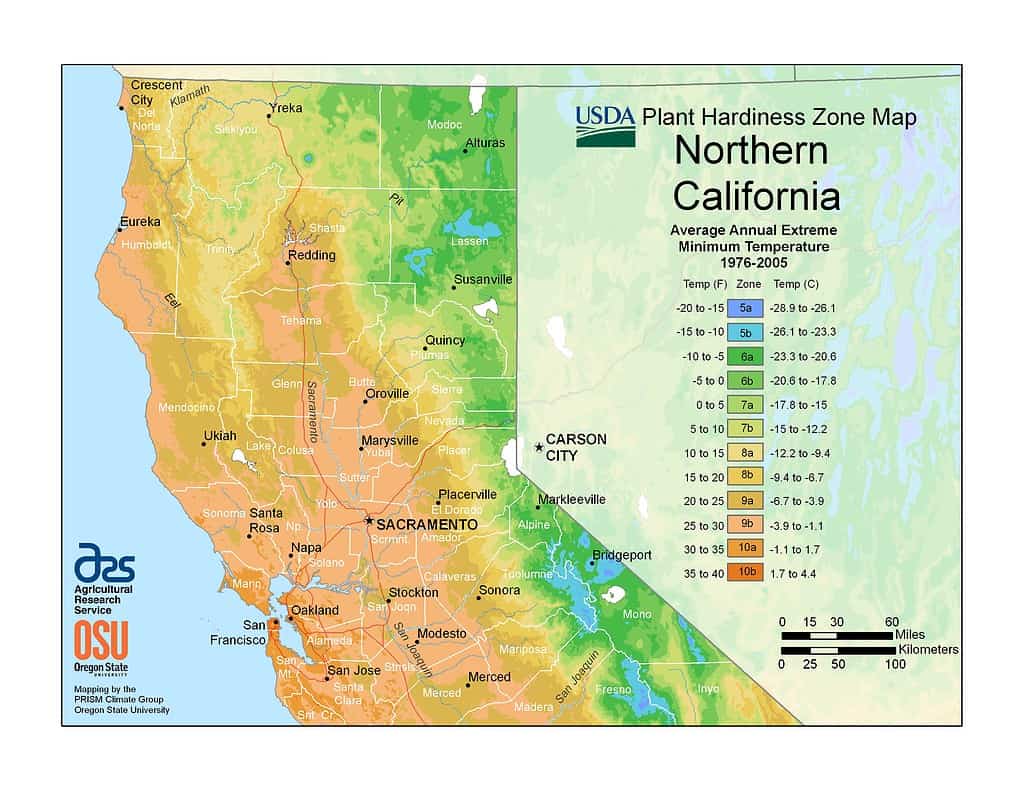
The Northern half of California experiences some low temperatures, and even some rain.
As mentioned earlier, Northern California tends to have colder Zones on average and has pockets that reach lower winter temperatures as compared to Southern Zones. In the north, Zones still span from 5a to 10b, so you should check your specific location to know where you fall in that range. As a general trend, Zones tend to drop as you move North and West on the map!
Once you know what exact Zone you live in, you can search for planting guides for your specific area. Guides based on hardiness maps tend to be more standard than those based on geographic region.
If you are interested in more basic guides though, there are a plethora of good tree and flower-picking guides for California as a whole.
Some plants that grow well in Northern California include:
- California lilac
- Oregon grape
- Redtwig dogwood
- California poppy
- California fuchsia
- Yarrow
- Western redbud
Southern California Hardiness Zones

Southern California tends to be more warm and dry, even during the winter months.
Southern California planting Zones tend to sway much more in the hot and dry direction. For the most part, the South consists of Zones from 8-11. There is some exception though for the upper northwest half, which has some pockets of lower Zones such as Zone 5 and 6.
Some plants that may succeed in Southern California weather include:
- California poppy
- Western sagebrush
- Lemonade berry
- California buckwheat
- Toyon
Tips for Keeping Plants Alive in California Zones
Now that we’ve discussed what the Zones are and where you may fall in the state, we can discuss some tips for keeping plants alive in California. Do note, each growing Zone can pose different challenges for growing plants. For instance, lower Zones may threaten your plants with harsh frosts, whereas higher Zones may wilt your plants with prolonged heat!
Take these helpful tips into account, but understand that every idea may not be the perfect solution for you.
1. Mulch Your Plants
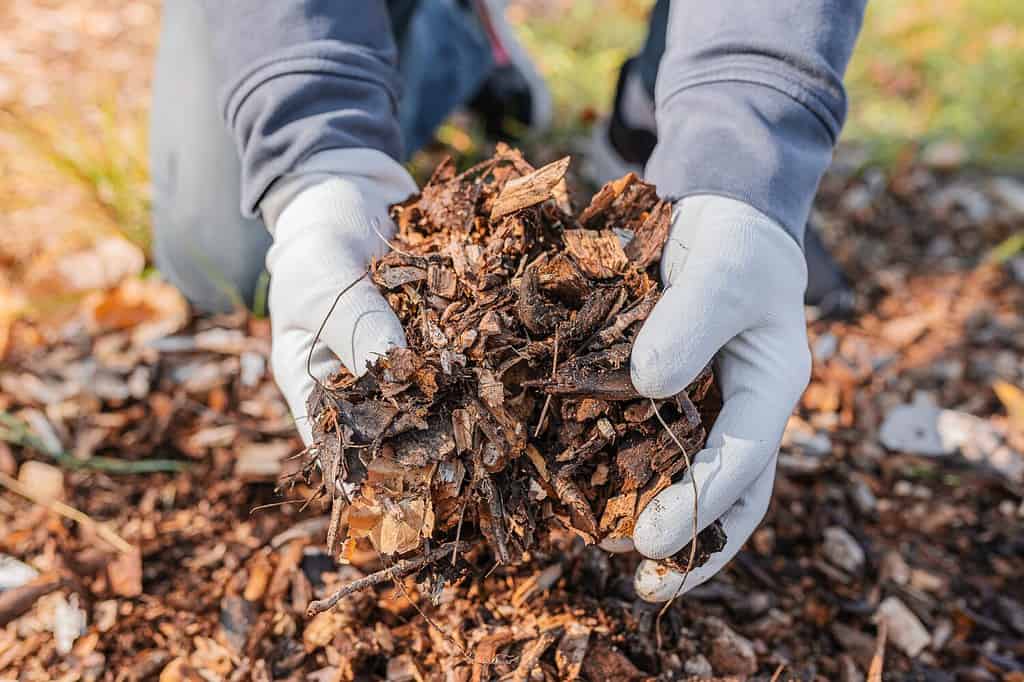
Mulching can regulate temperature, retain moisture, and fertilize your soil over time. It can be one of the best additions to your garden!
©larisa Stefanjuk/Shutterstock.com
One of the most beneficial things you can do for your plants in any situation is mulching. Mulching refers to the process of putting some sort of addition to the top of your soil. There are many uses for mulch, such as to trap moisture, protect delicate plants, or regulate temperature.
Mulch is an extremely common product in garden and home improvement stores. There are many different kinds, ranging from large nuggets of bark to well-ground organic mulch. Each has its own pros and cons, however, the general idea is to cover your soil.
For California gardeners, mulching is primarily beneficial because it helps to retain moisture and regulate temperature under hot drought conditions. Thus, mulching can be especially helpful in growing Zones that experience consistently high temperatures. Mulching can also protect plants from frost, so it may also have some use for gardeners in lower growing Zones.
2. Use Native Plants
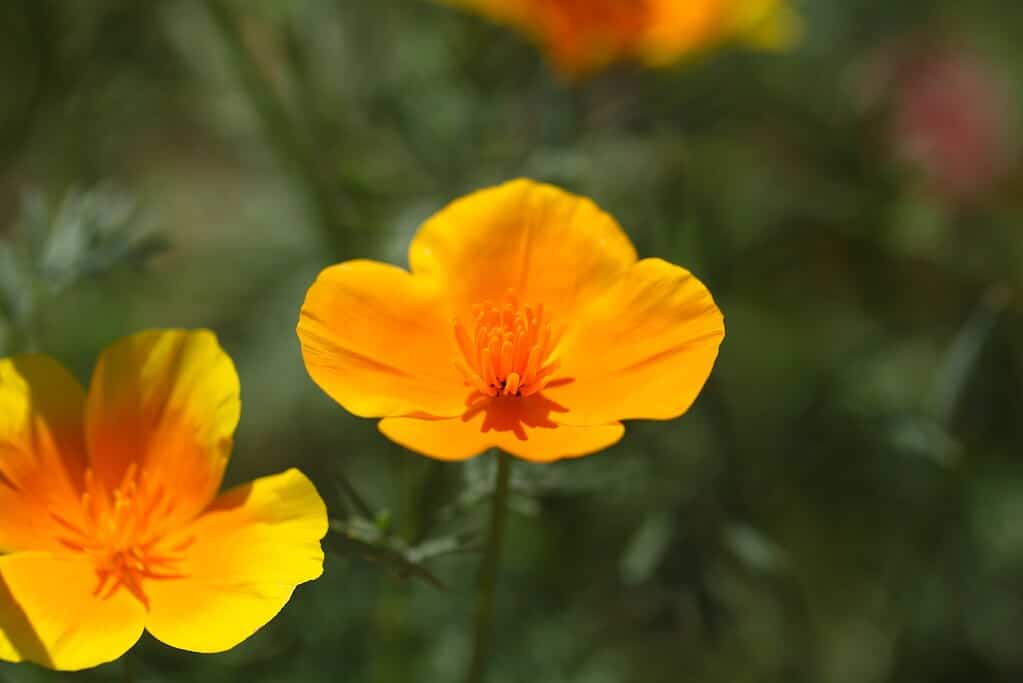
California has many gorgeous native plants such as the California poppy, which all are accustomed to growing in the area.
©ChWeiss/Shutterstock.com
One tip that many gardeners agree with is that using native plants is the key to success in gardening. Put simply, native plants are already accustomed to climate conditions within their native range, making them essentially hardy by nature.
Native plants aren’t just great for withstanding record low and high temperatures though. They often can tolerate other stressful conditions such as low-nutrient soil and drought!
If you want to learn more, take a look at some of the best native plants to grow in California.
3. Plan Your Watering Schedule
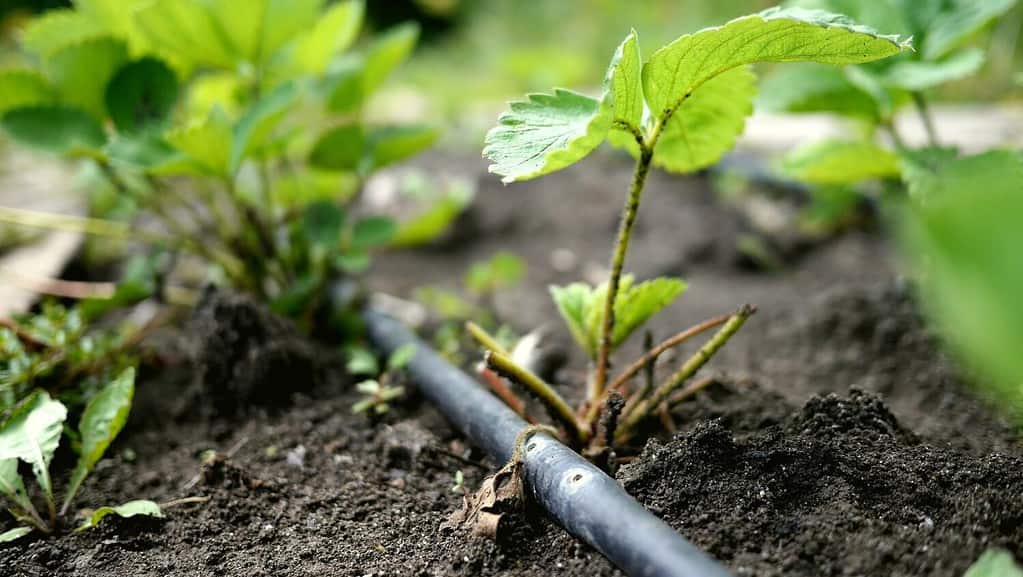
Drip irrigation is often recommended to conserve water while also reducing the threat of disease to your plants.
©Nadeene/Shutterstock.com
One thing that is incredibly important for California gardening is watering. The increasingly high temperatures put stress on plants, which already require a fair amount of water. Thus, planning your watering schedule so that it is optimal for saving water while nourishing your plants is a must.
Most sources agree that it is best to water your plants in the early morning before the heat of the day sets in.
4. Reduce Fertilizer Use During Heat Waves
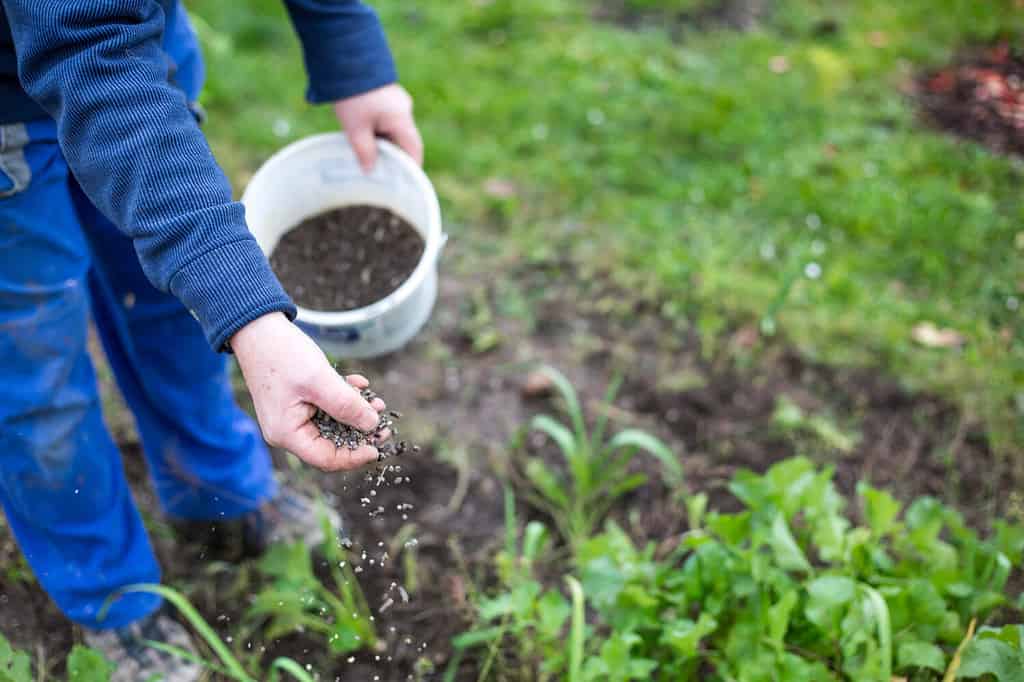
It is best to only use fertilizer sparingly. In addition to maintaining the balance of soil health, regulating fertilizer usage can also be more beneficial to your plants.
©Simon Kadula/Shutterstock.com
Although we all love to coddle our plants with all of the nutrients and water they need, it may be best to hold off on the fertilizer during times of stress. When plants are exposed to more nutrients, they often respond by producing more leaves.
While this sounds like a beneficial scenario, putting on new leaves during extreme temperature events can be a death sentence for your plant. Thus, consider reducing your fertilizer usage during droughts and winter storms.
5. Use a Shade Cloth If It’s Too Hot

Shade cloth can be a great low budget way to protect your plants in a pinch, especially if it is only for a short heat wave.
©VPales/Shutterstock.com
If the temperatures do rise to record highs, using shade cloth is a great solution to protect your plants. Shade cloth is a material that looks like a fine black mesh. When draped over delicate plants, it can block out a percentage of the sunlight, reducing the beating your plant takes during heat waves.
If you are looking to protect your whole garden, you can also string up shade cloth on poles. Elevated shade close can act as a tent for your whole garden. This allows you to protect as many plants as possible in one small area.
6. Don’t Water Your Plant’s Leaves
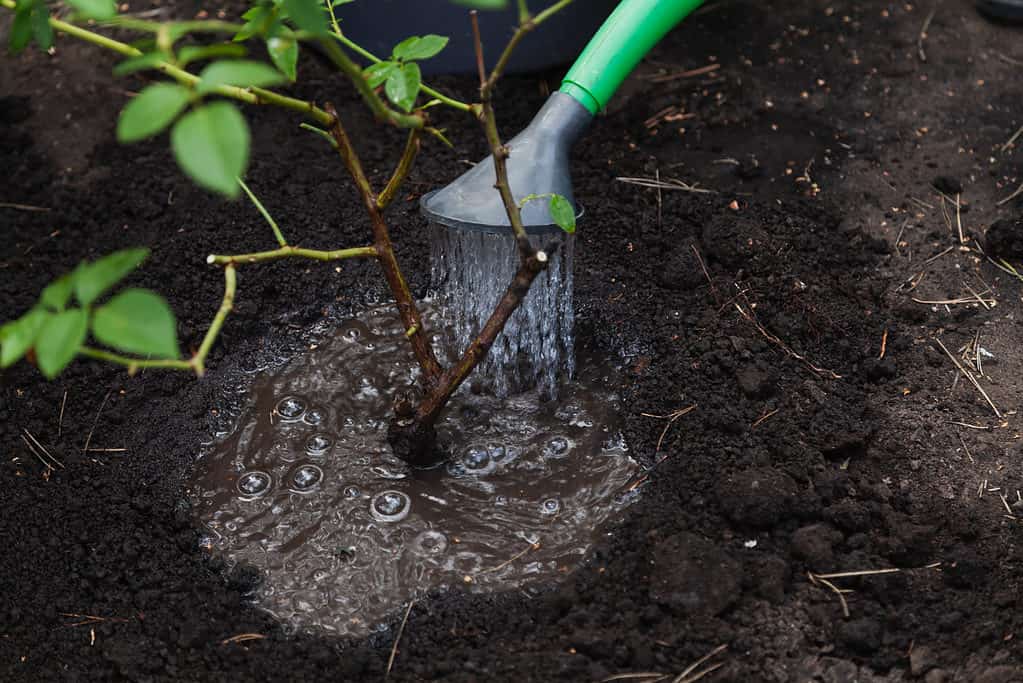
Prevent watering your plant’s leaves by watering directly at the soil level.
©iStock.com/glebchik
You should try to be very specific in how you water your plants. Getting your plant’s leaves wet can leave them susceptible to pathogens. The introduction of sickness to your plants can put them under extra stress. This stress is in addition to any weather-related issues they may be facing.
In California’s planting Zones, watering your whole plant can be tempting, but remember that it can be dangerous!
Thus, it is recommended to only water the soil surrounding your plant, making sure to keep your plant’s leaves as dry as possible. This can be hard if you are using a sprinkler system, however, many people swear by using drip lines or hand-watering.
7. Don’t Prune If Your Plants Are Stressed

Although it can be tempting, pruning can often put extra stress on plants during a heat wave.
©New Africa/Shutterstock.com
Another tip related to California’s heat waves is to reduce the amount of pruning you do during this time. Under extremely high or low-temperature conditions, most plants are put under stress. This means they are more susceptible to disease and illness. Pruning your plants creates direct wounds on their stem, which can be a direct line for pathogens to enter. Additionally, the stress that pruning naturally puts on a plant usually adds on top of heat stress. Thus, you should stop pruning if your plant is already battling the heat.
8. Plant Items Close Together
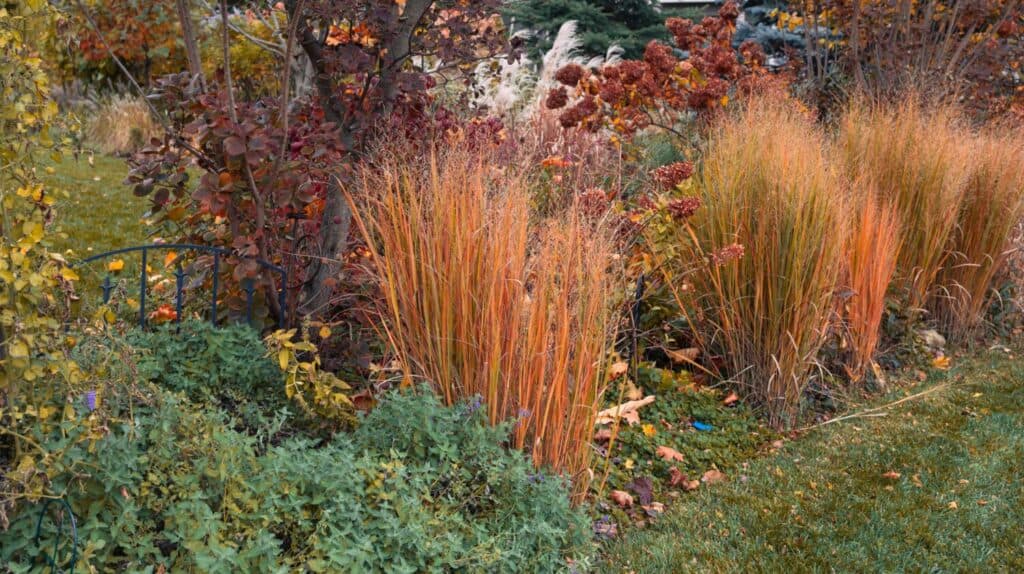
Planting a variety of different plants in the same area can create a microclimate that withstands heat stress.
©Molly Shannon/Shutterstock.com
One last tip for dealing with high temperatures specifically is to plant items relatively close together. This is especially true if you are planting things that grow to different heights such as trees and flowers. In California’s planting Zones, heat is a big issue that can stress out isolated plants.
The general idea is that planting things that grow at different levels in the same area effectively creates a microclimate by creating shade. Bigger plants such as trees can handle the heat better. They also create pockets of mottled shade for your more delicate plants to grow under.
Some plants are even known to grow better when they are closer together. This is likely because they can share water when needed.
You should be careful, however, planting items too close together can also cause its own slew of problems. For instance, plants that are packed in extreme proximity can trap moisture on their leaves, increasing the chance of disease spreading through your garden. Additionally, if your soil is limited in nutrients or water, close plants may compete with each other, putting more stress on your garden than you would have experienced in the first place.
Regardless, as long as you make sure your plants have a little wiggle room, and that your garden is supplied with ample water and nutrients, planting things close together can help your garden succeed in the heat!
Summary of Tips for Keeping Plants Alive in California
| 8 Tips for Keeping Flowers, Trees, and Shrubs Alive in California | |
|---|---|
| 1. | Mulch your plants to protect them. |
| 2. | Use native plants that withstand the heat and cold. |
| 3. | Water regularly when it is not too hot. |
| 4. | Don’t fertilize if your plant is stressed. |
| 5. | Use a shade cloth during heat waves. |
| 6. | Refrain from watering your plant’s leaves. |
| 7. | Don’t prune if it’s too hot. |
| 8. | Create microclimates by planting diverse plants together. |
The photo featured at the top of this post is © iStock.com/TheCrimsonRibbon
Thank you for reading! Have some feedback for us? Contact the AZ Animals editorial team.







